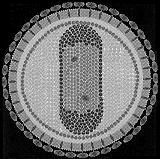Equine infectious anemia virus
| Equine infectious anemia virus | ||||||||||||||||||||
|---|---|---|---|---|---|---|---|---|---|---|---|---|---|---|---|---|---|---|---|---|

Equine infectious anemia virus |
||||||||||||||||||||
| Systematics | ||||||||||||||||||||
|
||||||||||||||||||||
| Taxonomic characteristics | ||||||||||||||||||||
|
||||||||||||||||||||
| Scientific name | ||||||||||||||||||||
| Equine infectious anemia virus | ||||||||||||||||||||
| Short name | ||||||||||||||||||||
| EIAV | ||||||||||||||||||||
| Left | ||||||||||||||||||||
|
The virus, equine infectious anemia , ( scientific Equine infectious anemia virus , EIA virus , EIAV ) is a retrovirus that the lentiviruses belongs. The contingent by this virus infection is the equine infectious anemia ( Equine Infectious Anemia ) and only animals affects the family of Horse (Equidae), so horses, donkeys , mules and mules , zebras , etc. The symptoms of anemia of horses was the Known to veterinarians in the 19th century. As early as 1904, it was possible to prove that it was a non-bacterial infectious disease. However, it took many decades before the nature of the infectious agent could be clarified.
properties
The EIA virus is an enveloped, single-stranded RNA virus of which various serotypes are known. It is sensitive to heat, direct sunlight, acidic pH levels, and fat solvents . In contrast to environmental influences, it is relatively stable; in dried blood it can remain infectious for up to seven months. Cold stabilizes the pathogen, at –4 ° C it can remain contagious for up to 5 years.
The EIAV was the first retrovirus to demonstrate mechanical transmission through blood-sucking insects .
In addition to fat solvents, strongly acidic and alkaline substances are suitable as disinfectants . The Friedrich Loeffler Institute also recommends detergents , halogen - derivatives or quaternary ammonium compounds . Formalin and glutaraldehyde are not very effective.
The approximately 8.2 kb virus genome is the smallest and genetically most simply constructed of all known lentiviruses. In addition to the retrovirus-typical gag , pol and env gene regions, the EIAV genome also has three further open reading frames which code for the Tat and Rev proteins typical of lentivurs , as well as for a third protein called S2.
Occurrence
The EIA virus is very rare in Germany. The main areas of distribution are North and South America, South Africa and Northern Australia, but the virus can be found worldwide. It can be transmitted from infected animals via common food or drink, as well as via blood-sucking insects ( vectors ).
Web links
- Equine Infectious Anemia Virus in the ICTV database
- B. Iben: Equine infectious anemia . In: Großtierpraxis . tape 7 , no. 12 , 2006, p. 510-521 ( pdf ).
Individual evidence
- ↑ a b c d ICTV: ICTV Taxonomy history: Commelina yellow mottle virus , EC 51, Berlin, Germany, July 2019; Email ratification March 2020 (MSL # 35)
- ↑ H. Vallée, H. Carré: Sur la nature infectieuse de l'anémie du cheval . In: Comptes Rendus Hebdomadaires des Seances Academie des Sciences. D: Sciences Naturales . tape 139 , 1904, pp. 331-333 (French, dvju ).
- ↑ C. Leroux, J.-L. Cadoré, RC Montelaro: Equine Infectious Anemia Virus (EIAV): what has HIV's country cousin got to tell us? In: Vet. Res. Band 35 , 2004, pp. 485-512 , doi : 10.1051 / vetres: 2004020 (English, pdf ).